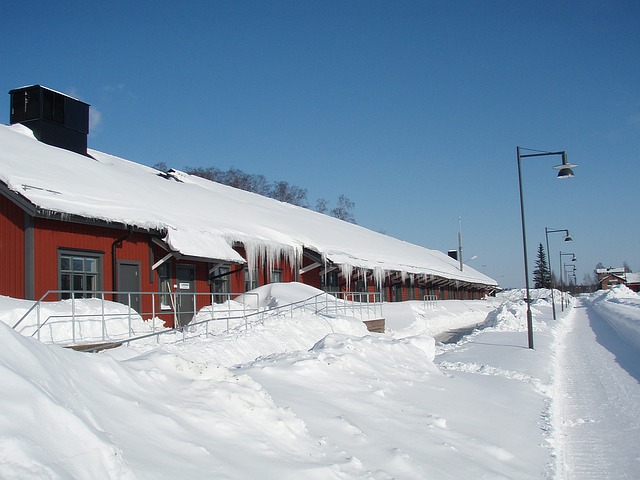Frost attack
Contents |
[edit] Introduction
Frost attack is a physical process which can have deleterious effects on building materials due to the repetitive cycles of freezing and thawing. It falls under the umbrella term ‘weathering’ and is also referred to as ‘frost action’, ‘freeze-thaw’ or ‘thaw-freeze’ cycles.
Frost attack can be damaging because some building materials (notably those that are course-grained) can allow water to enter their interstices. As water freezes in low temperatures, it undergoes a volumetric expansion of around 9%. If this expansion cannot be accommodated by the material, the pressures created can result in disintegration. The process is almost can be accompanied by unsightly deterioration of the surface.
Frost action is more likely to occur in cold, damp or wet environments where surfaces are likely to remain saturated for long periods and where temperatures frequently fluctuate above and below freezing point e.g warmer in the day and colder at night. The freeze-thaw cycle is based not only on the amount of moisture present in a material or the low temperatures, but also on the relative humidity of the surrounding air.
The parts of a building that are more prone to saturation and frost action are those that are more exposed to the elements (ie not sheltered from wind-driven rain) and are more often saturated, such as on the upper reaches of a building, in parapets and freestanding walls. Also vulnerable are areas of brickwork near to the ground and below the damp-proof course (DPC), as are areas that are continually damp as a result of a missing or faulty DPC, drainage problems, leaks and so on.
[edit] Brickwork
Clay brickwork and paving may be vulnerable to frost attack but this will depend on the type of clay – most brick types are frost resistant if properly installed. When water penetrates a brick that is not classed as frost resistant, repetitive cycles of frost action can cause the face of the brickwork to blow off, a process that is known as ‘spalling’ or ‘blowing’. Engineering bricks, with their smooth, hard surfaces can usually resist this process.
In parapets and freestanding walls – which are almost always more exposed than other brickwork – the omission of a damp-proof course below the coping or capping can allow water penetration deep into the wall body, allowing large bands of wall to remain saturated and so be more prone to frost attack.
Mortar is also subject to frost attack, in particular when used in conjunction with a hard, low water absorption brick which concentrates more surface water on to the joints.
For more information see: Defects in brickwork.
[edit] Stone
Frost action can also have long-term consequences on sedimentary stones, in particular on those that are relatively porous, such as Bath stone, some limestones and many sandstones. Some traditional techniques can be used to delay the onslaught of the process. This includes laying the stone (or stone cladding) in its ‘natural bed’, ie, the way it lay in the quarry: a block laid on its side will be far vulnerable to wind, rain and frost attack (a process called ‘flaking’).
For more information see: Defects in stonework.
[edit] Concrete
Concrete paths may crack and spall as a result of frost attack. This may be the result of a weak mix or the incorporation of pockets of air where moisture can accumulate. A strong mix that is well compacted may prevent the phenomenon from occurring, as may paving slabs and blocks that are frost resistant.
[edit] Related articles on Designing Buildings
- Brick.
- Condensation.
- Cracking in buildings.
- Damp proof course.
- Defects in brickwork.
- Defects in stonework.
- Efflorescence.
- How to lay bricks.
- Mortar.
- Mould growth.
- Parapet.
- Pattern staining and soiling in stonework.
- Penetrating damp.
- Permafrost.
- Repointing.
- Rising damp.
- Rising damp in walls - diagnosis and treatment (DG 245).
- Sea ice.
- Slaking.
- Spalling.
- Specifying brick.
- Stain.
- Treating brickwork with sealant or water repellent.
- Types of brick bonding.
- Understanding dampness.
- Which way up should you lay a brick?
Featured articles and news
A change to adoptive architecture
Effects of global weather warming on architectural detailing, material choice and human interaction.
How big is the problem and what can we do to mitigate the effects?
Overheating guidance and tools for building designers
A number of cool guides to help with the heat.
The UK's Modern Industrial Strategy: A 10 year plan
Previous consultation criticism, current key elements and general support with some persisting reservations.
Building Safety Regulator reforms
New roles, new staff and a new fast track service pave the way for a single construction regulator.
Architectural Technologist CPDs and Communications
CIAT CPD… and how you can do it!
Cooling centres and cool spaces
Managing extreme heat in cities by directing the public to places for heat stress relief and water sources.
Winter gardens: A brief history and warm variations
Extending the season with glass in different forms and terms.
Restoring Great Yarmouth's Winter Gardens
Transforming one of the least sustainable constructions imaginable.
Construction Skills Mission Board launch sector drive
Newly formed government and industry collaboration set strategy for recruiting an additional 100,000 construction workers a year.
New Architects Code comes into effect in September 2025
ARB Architects Code of Conduct and Practice available with ongoing consultation regarding guidance.
Welsh Skills Body (Medr) launches ambitious plan
The new skills body brings together funding and regulation of tertiary education and research for the devolved nation.
Paul Gandy FCIOB announced as next CIOB President
Former Tilbury Douglas CEO takes helm.
UK Infrastructure: A 10 Year Strategy. In brief with reactions
With the National Infrastructure and Service Transformation Authority (NISTA).
Ebenezer Howard: inventor of the garden city. Book review.
Airtightness Topic Guide BSRIA TG 27/2025
Explaining the basics of airtightness, what it is, why it's important, when it's required and how it's carried out.






















